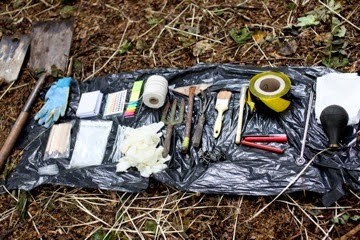
AirSpace Gallery
Autumn / Winter 2014
After a really successful Summer Residency Season, which saw Andrew Burton and Vulpes Vulpes explore ideas around Brownfield and Social Gatherings, we get a sense that Autumn is on its way, and as ever, AirSpace has a packed programme. Here's a taster of what's coming up, with exhibitions, events and opportunities for you to get involved.
We really hope to see you at one, more or ALL of these great events!!
OPPORTUNITIES
 GRADUATE MICRO RESIDENCIES - 2 x £500 awards available to recent Staffordshire University visual arts graduates. DEADLINE September 8th
GRADUATE MICRO RESIDENCIES - 2 x £500 awards available to recent Staffordshire University visual arts graduates. DEADLINE September 8thAs part of the ArtCity initiative, a brand new Residency Programme will start this year in Stoke-on-Trent, involving artists Shaun Doyle, Mally Mallinson, Chloe Cooper, Leslie Deere and Leigh Clarke. As yet to be named, the project is intended as an ongoing programme, establishing a residency of national importance utilizing the city’s vacant commercial properties and skill base. We envisage a public facing, communicative, responsive programme that involves a strong education element, building ties to local schools and colleges. READ MORE
 THE CHECKERBOARD CREW with ADAM JAMES
THE CHECKERBOARD CREW with ADAM JAMESSeptember 6th/7th
As part of the forthcoming AirSpace Gallery / Potteries Museum and Art Gallery exhibition, "The Artist And The City" artist Adam James is running a LARP, here in Stoke-on-Trent. And there are opportunities to be a central part of it! READ MORE and BOOK YOUR PLACE HERE
THE ARTIST SOUP KITCHEN - BITING THE HAND THAT FEEDS WITH SUSAN JONES - October 18th

To mark the final day of the exhibition Coming Up For Air, art world legend and A-N Magazine's soon-to-be-departing Chief, Susan Jones will be the guest speaker at the 5th installment of our Artist Soup Kitchen Series. Drawing on the themes from the exhibition, Susan will present present the case for the importance of artist-led activity and the compelling need for effective advocacy in the area.
There are 10 places available for this not to be missed opportunity for delicious homemade soup, bread and bespoke art-chat. READ MORE and BOOK YOUR PLACE
EVENTS
 BENEATH THE PAVEMENT - The Presentation
BENEATH THE PAVEMENT - The PresentationWednesday 24th September, 2014 4pm-6pm
In July, 2014, Appetite and the City Centre Partnership commissioned AirSpace Gallery to design a consultation and visioning programme designed to work with artists to find spaces and opportunities in the city centre for artists and other creative practitioners to work, put on events and activities, but also to consider how the city might work differently.
The Presentation event will see the unveiling of these exciting, thoughtful and sideways thinking proposals at the launch of the Beneath the Pavement Presentation Event. The launch is set to be an experience in itself, inviting attendees to explore and reimagine the city with us.
READ MORE and BOOK YOUR PLACE HERE
EXHIBITIONS
We have TWO major exhibitions coming up before the end of the year.
COMING UP FOR AIR
September 12th - October 18th 2014 - PV :September 12th 6pm-9pm

CAMPBELL WORKS re-examine what constitutes an ‘artwork’ and peruses the idea that an artwork is ‘the final manifestation of a multitude of elements drawn together from external sources and re-formatted into new and unexpected configurations’, enabling alternative understandings to be drawn from the original elements. READ MORE
 THE ARTIST AND THE CITY
THE ARTIST AND THE CITYPMAG - 4th Oct, 2014 - 22nd February. 2015
AirSpace - 31st October - 13th December, 2014
Public Preview - PMAG / AirSpace - 31st October, 6pm-9pm
A collaborative exhibition between AirSpace Gallery and The Potteries Museum and Art Gallery, Stoke-on-Trent, curated by Jean Milton and Anna Francis.
Ahead of Stoke-on-Trent’s Esmee Fairburn funded project, ArtCity , AirSpace Gallery and the Potteries Museum and Art Gallery have worked together on an exhibition entitled 'The Artist and The City', exploring the idea that considering Stoke’s history of creative industries and artists working in the city, it is and has always been a Creative City. READ MORE















































